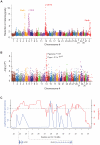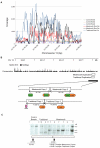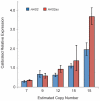A novel unstable duplication upstream of HAS2 predisposes to a breed-defining skin phenotype and a periodic fever syndrome in Chinese Shar-Pei dogs
- PMID: 21437276
- PMCID: PMC3060080
- DOI: 10.1371/journal.pgen.1001332
A novel unstable duplication upstream of HAS2 predisposes to a breed-defining skin phenotype and a periodic fever syndrome in Chinese Shar-Pei dogs
Abstract
Hereditary periodic fever syndromes are characterized by recurrent episodes of fever and inflammation with no known pathogenic or autoimmune cause. In humans, several genes have been implicated in this group of diseases, but the majority of cases remain unexplained. A similar periodic fever syndrome is relatively frequent in the Chinese Shar-Pei breed of dogs. In the western world, Shar-Pei have been strongly selected for a distinctive thick and heavily folded skin. In this study, a mutation affecting both these traits was identified. Using genome-wide SNP analysis of Shar-Pei and other breeds, the strongest signal of a breed-specific selective sweep was located on chromosome 13. The same region also harbored the strongest genome-wide association (GWA) signal for susceptibility to the periodic fever syndrome (p(raw) = 2.3 × 10⁻⁶, p(genome) = 0.01). Dense targeted resequencing revealed two partially overlapping duplications, 14.3 Kb and 16.1 Kb in size, unique to Shar-Pei and upstream of the Hyaluronic Acid Synthase 2 (HAS2) gene. HAS2 encodes the rate-limiting enzyme synthesizing hyaluronan (HA), a major component of the skin. HA is up-regulated and accumulates in the thickened skin of Shar-Pei. A high copy number of the 16.1 Kb duplication was associated with an increased expression of HAS2 as well as the periodic fever syndrome (p < 0.0001). When fragmented, HA can act as a trigger of the innate immune system and stimulate sterile fever and inflammation. The strong selection for the skin phenotype therefore appears to enrich for a pleiotropic mutation predisposing these dogs to a periodic fever syndrome. The identification of HA as a major risk factor for this canine disease raises the potential of this glycosaminoglycan as a risk factor for human periodic fevers and as an important driver of chronic inflammation.
Conflict of interest statement
The authors KL-T, MO, and LT have filed a patent for development of a genetic test.
Figures





Similar articles
-
Hereditary cutaneous mucinosis in shar pei dogs is associated with increased hyaluronan synthase-2 mRNA transcription by cultured dermal fibroblasts.Vet Dermatol. 2009 Oct;20(5-6):377-82. doi: 10.1111/j.1365-3164.2009.00799.x. Vet Dermatol. 2009. PMID: 20178474
-
Increased HAS2-driven hyaluronic acid synthesis in shar-pei dogs with hereditary cutaneous hyaluronosis (mucinosis).Vet Dermatol. 2011 Dec;22(6):535-45. doi: 10.1111/j.1365-3164.2011.00986.x. Epub 2011 Jul 1. Vet Dermatol. 2011. PMID: 21718367
-
A study of Shar-Pei dogs refutes association of the 'meatmouth' duplication near HAS2 with Familial Shar-Pei Fever.Anim Genet. 2014 Oct;45(5):763-4. doi: 10.1111/age.12193. Epub 2014 Jul 5. Anim Genet. 2014. PMID: 25040095 No abstract available.
-
Skin diseases of the Chinese Shar-Pei.Vet Clin North Am Small Anim Pract. 1990 Nov;20(6):1655-70. doi: 10.1016/s0195-5616(90)50166-7. Vet Clin North Am Small Anim Pract. 1990. PMID: 2251744 Review.
-
Insights into morphology and disease from the dog genome project.Annu Rev Cell Dev Biol. 2014;30:535-60. doi: 10.1146/annurev-cellbio-100913-012927. Epub 2014 Jul 9. Annu Rev Cell Dev Biol. 2014. PMID: 25062362 Free PMC article. Review.
Cited by
-
Evaluation of hyaluronic acid, procollagen type III N-terminal peptide, and tissue inhibitor of matrix metalloproteinase-1 as serum markers of canine hepatic fibrosis.Can J Vet Res. 2016 Oct;80(4):302-308. Can J Vet Res. 2016. PMID: 27733785 Free PMC article.
-
Genome-wide analysis in German shepherd dogs reveals association of a locus on CFA 27 with atopic dermatitis.PLoS Genet. 2013 May;9(5):e1003475. doi: 10.1371/journal.pgen.1003475. Epub 2013 May 9. PLoS Genet. 2013. PMID: 23671420 Free PMC article.
-
Body size, inbreeding, and lifespan in domestic dogs.Conserv Genet. 2020 Feb;21(1):137-148. doi: 10.1007/s10592-019-01240-x. Epub 2019 Dec 5. Conserv Genet. 2020. PMID: 32607099 Free PMC article.
-
Analysis of copy number variation in dogs implicates genomic structural variation in the development of anterior cruciate ligament rupture.PLoS One. 2020 Dec 31;15(12):e0244075. doi: 10.1371/journal.pone.0244075. eCollection 2020. PLoS One. 2020. PMID: 33382735 Free PMC article.
-
Multiple FGF4 Retrocopies Recently Derived within Canids.Genes (Basel). 2020 Jul 23;11(8):839. doi: 10.3390/genes11080839. Genes (Basel). 2020. PMID: 32717834 Free PMC article.
References
-
- Fraser JR, Laurent TC, Laurent UB. Hyaluronan: its nature, distribution, functions and turnover. Journal of Internal Medicine. 1997;242:27–33. - PubMed
-
- Wheeler-Jones CP, Farrar CE, Pitsillides AA. Targeting hyaluronan of the endothelial glycocalyx for therapeutic intervention. Current Opinion in Investigational Drugs. 2010;11(9):997–1006. - PubMed
-
- Laurent TC, Fraser JRE. Hyaluronan. FASEB J. 1992;6:2397–2404. - PubMed
-
- Zanna G, Fondevila D, Bardagi M, Docampo MJ, Bassols A, et al. Cutaneous mucinosis in shar-pei dogs is due to hyaluronic acid deposition and is associated with high levels of hyaluronic acid in serum. Vet Dermatol. 2008;19:314–318. - PubMed
-
- Ramsden CA, Bankier A, Brown TJ, Cowen PSJ, Frost GI. A new disorder of hyaluronan metabolism associated with generalized folding and thickening of the skin. J of Ped. 2000;36:62–68. - PubMed
Publication types
MeSH terms
Substances
LinkOut - more resources
Full Text Sources
Other Literature Sources
Medical

